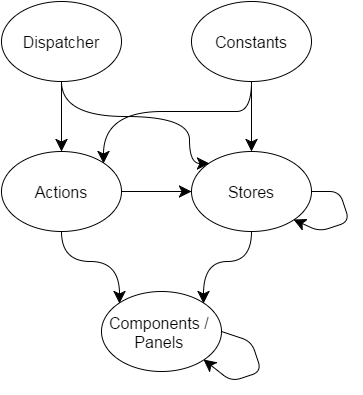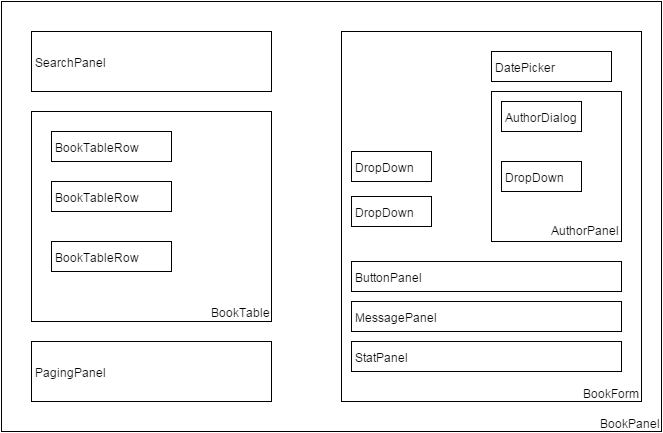Introduction
One of my favorite django apps is django-tables2: It allows you to easily create pagination and sorting enabled HTML tables to represent your model data using the usual djangonic technique (similar to how you create ModelForms). I use it to almost all my projects to represent the data, along with django-filter to create forms to filter my model data. I’ve written a nice SO answer with instructions on how to use django-filter along with django-tables2. This article will describe a technique that allows you to generate tables and filters for your models in the most DRY way!
The problem we’ll solve
The main tool django-tables2 offers is a template tag called render_table that gets an instance of a subclass of django_tables2.Table which contains a description of the table (columns, style etc) along with a queryset with the table’s data and outputs it to the page. A nice extra feature of render_table is that you could pass it just a simple django queryset and it will output it without the need to create the custom Table class. So you can do something like {% render_table User.objects.all() %} and get a quick output of your Users table.
In one of my projects I had three models that were used for keeping a different type of business log in the database (for auditing reasons) and was using the above feature to display these logs to the administrators, just by creating a very simple ListView (a different one for each Log type) and using the render_table to display the data. So I’d created three views limilar to this:
class AuditLogListView(ListView):
model = AuditLog
context_object_name = 'logs'
which all used a single template that contained a line {% render_table logs %} to display the table (the logs context variable contains the list/queryset of AuditLog s) so render_table will just output that list in a page. Each view of course had a different model attribute.
This was a nice DRY (but quick and dirty solution) that soon was not enough to fulfill the needs of the administrators since they neeeded to have default sorting, filtering, hide the primary key-id column etc. The obvious solution for that would be to just create three different Table subclasses that would more or less have the same options with only their model attributte different. I didn’t like this solution that much since it seemed non-DRY to me and I would instead prefer to create a generic Table (that wouldn’t have a model attributte) and would just output its data with the correct options — so instead of three Table classes I’d like to create just a single one with common options that would display its data (what render_table does).
Unfortunately, I couldn’t find a solution to this, since when I ommited the model attribute from the Table subclass nothing was outputed (there is no way to define fields to display in a Table without also defining the model). An obvious (and DRY) resolution would be to create a base Table subclass that would define the needed options and create three subclasses that would inherit from this class and override only the model attribute. This unfortunately was not possible becase inheritance does not work well with django-tables2!
Furthermore, there’s the extra hurdle of adding filtering to the above tables so that the admin’s would be able to quickly find a log message - if we wanted to use django-filter we’d need again to create three different subclasses (one for each log model type) of django_filter.FilterSet since django-filter requires you to define the model for which the filter will be created!
One cool way to resolve such problems is to create your classes dynamically when you need ‘em. I’ve already described a way to dynamically create forms in django in a previous post. Below, I’ll describe a similar technique which can be used to create both dynamic tables and filters. Using this methodology, you’ll be able to add a new CBV that displays a table with pagination, order and filtering for your model by just inheriting from a base class!
Adding the dynamic table
To create the DRY CBV we’ll use the SingleTableView (django_tables2.SingleTableView) as a base and override its get_table_class method to dynamically create our table class using type. Here’s how it could be done using a mixin (notice that this mixin should be used in a SingleTableView to override its get_table_class method):
class AddTableMixin(object, ):
table_pagination = {"per_page": 25}
def get_table_class(self):
def get_table_column(field):
if isinstance(field, django.db.models.DateTimeField):
return tables.DateColumn("d/m/Y H:i")
else:
return tables.Column()
attrs = dict(
(f.name, get_table_column(f)) for
f in self.model._meta.fields if not f.name == 'id'
)
attrs['Meta'] = type('Meta', (), {'attrs':{"class":"table"}, "order_by": ("-created_on", ) } )
klass = type('DTable', (tables.Table, ), attrs)
return klass
Let’s try to explain the get_table_class method: First of all, we’ve defined a local get_table_column function that will return a django-tables2 column depending on the field of the model. For example, in our case I wanted to use a django_tables2.DateColumn with a specific format when a DateTimeField is encountered and for all other model fields just use the stock Column. You may add other overrides here, for example add a TemplateColumn to properly render some data.
After that, we create a dictionary with all the attributes of the dynamic table model. The self.model field will contain the model Class of this SingleTableView, so using its _meta.fields will return the defined fields of that model. As we can see, I just use a generator expression to create a tuple with the name of the field and its column type (using get_table_column) excluding the ‘id’ column. So, attrs will be a dictionary of field names and column types. Here you may also exclude other columns you don’t want to display.
The Meta class of this table is crated using type which creates a parentless class by defining all its attributes in a dictionary and set it as the Meta key in the previously defined attrs dict. Finally, we create the actual django_tables2.Table subclass by inheriting from it and passing the attrs dict. We’ll see an example of what get_table_class returns later.
Creating a dynamic form for filtering
Let’s create another mixin that could be used to create a dynamic django.Form subclass to the CBV:
class AddFormMixin(object, ):
def define_form(self):
def get_form_field_type(f):
return forms.CharField(required=False)
attrs = dict(
(f, get_form_field_type(f)) for
f in self.get_form_fields() )
klass = type('DForm', (forms.Form, ), attrs)
return klass
def get_queryset(self):
form_class = self.define_form()
if self.request.GET:
self.form = form_class(self.request.GET)
else:
self.form = form_class()
qs = super(AddFormMixin, self).get_queryset()
if self.form.data and self.form.is_valid():
q_objects = Q()
for f in self.get_form_fields():
if self.form.cleaned_data.get(f):
q_objects &= Q(**{f+'__icontains':self.form.cleaned_data[f]})
qs = qs.filter(q_objects)
return qs
def get_context_data(self, **kwargs):
ctx = super(AddFormMixin, self).get_context_data(**kwargs)
ctx['form'] = self.form
return ctx
The first method that will be called is the get_queryset method that will generate the dynamic form using define_form. This method has a get_form_field_type local function (similar to get_table_fields) that can be used to override the types of the fields (or just fallback to a normal CharField) and then create the attrs dictionary and forms.Form subclass in a similar way as the Table subclass. Here, we don’t want to create a filter form from all fields of the model as we did on table, so instead we’ll use a get_form_fields (don’t confuse it with the local get_form_field_type) method that returns the name of the fields that we want to use in the filtering form and needs to be defined in each CBV — the get_form_fields must be defined in classes that use this mixin.
After defining the form, we need to check if there’s anything to the GET dict — since we are just filtering the queryset we’d need to submit the form with a GET (and not a POST). We see that if we have data to our request.GET dictionary we’ll instantiate the form using this data (or else we’ll just create an empty form). To do the actual filtering, we check if the form is valid and create a django.models.db.Q object that is used to combine (by AND) the conditions. Each of the individual Q objects that will be combined (&=) to create the complete one will be created using the line Q(**{f+'__icontains':self.form.cleaned_data.get(f, '')}) (where f will be the name of the field) which is a nice trick: It will create a dictionary of the form {'action__icontains': 'test text'} and then pass this as a keyword argument to the Q (using the ** mechanism), so Q will be called like Q(action__icontains='test text') - this (using the **{key:val} trick) is the only way to pass dynamic kwargs to a function!
Finally, the queryset will be filtered using the combined Q object we just described.
Creating the dynamic CBV
Using the above mixins, we can easily create a dynamic CBV with a table and a filter form only by inheriting from the mixins and SingleTableView and defining the get_form_fields method:
class AuditLogListView(AddTableMixin, AddFormMixin, SingleTableView):
model = AuditLog
context_object_name = 'logs'
def get_form_fields(self):
return ('action','user__username', )
Let’s suppose that the AuditLog is defined as following:
class AuditLog(models.Model):
created_on = models.DateTimeField( auto_now_add=True, editable=False,)
user = models.ForeignKey(settings.AUTH_USER_MODEL, editable=False,)
action = models.CharField(max_length=256, editable=False,)
Using the above AuditLogListView, a dynamic table and a dynamic form will be automaticall created whenever the view is visited. The Table class will be like this:
class DTable(tables.Table):
created_on = tables.DateColumn("d/m/Y H:i")
user = tables.Column()
action = tables.Column()
class Meta:
attrs = {"class":"table"}
order_by = ("-created_on", )
and the Form class like this:
class DForm(forms.Form):
user__username = forms.CharField()
action = forms.CharField()
An interesting thing to notice is that we can drill down to foreign keys (f.e. user__username) to create more interesting filters. Also we could add some more methods to be overriden by the implementing class beyond the get_form_fields. For example, instead of using self.model._meta.fields to generate the fields of the table, we could instead use a get_table_fields (similar to the get_form_fields) method that would be overriden in the implementing classes (and even drill down on foreign keys to display more data on the table using accessors).
Or, we could also define the form field types and lookups (instead of always using CharField and icontains ) in the get_form_fields — similar to django-filter.
Please notice that instead of creating a django form instance for filtering, we could instead create a django-filter instance with a similar methodology. However, I preferred to just use a normal django form because it makes the whole process more clear and removes a level of abstraction (we just create a django.Form subclass while, if we used django-filter we’d need to create a django-filter subclass which would create a django.Form subclass)!
Conclusion
Using the above technique we can quickly create a table and filter for a number of Models that all share the same properties in the most DRY. This technique of course is useful only for quick CBVs that are more or less the same and require little customization. Another interesting thing is that instead of creating different SingleTableView s we could instead create a single CBV that will get the content type of the Model to be viewed as a parameter and retrieve the model (and queryset) from the content type - so we could have a single CBV for all our table/filtering views !




